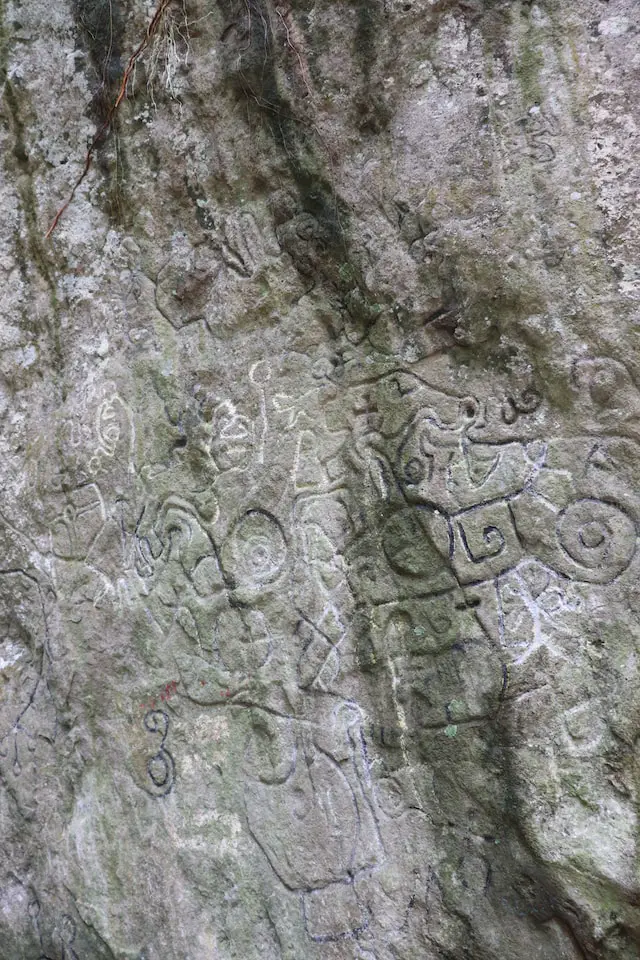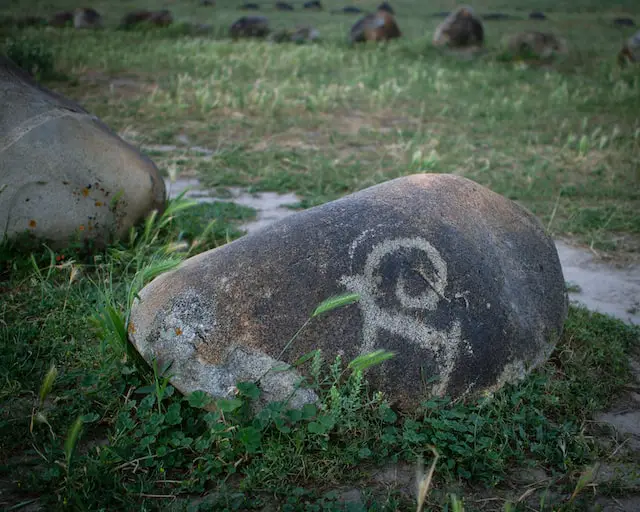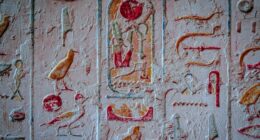A lithograph refers to a printed image produced using a stone or metal plate. Petroglyph, on the other hand, refers to rock carvings or engravings made by ancient people on natural rock surfaces.
What is a Lithograph?
(Photo By Jones Library on Flickr)

A lithograph is a method of printing from a flat surface. The image is first drawn or painted onto the surface and then transferred to a stone or metal plate. The inked image on the plate is then transferred to paper, resulting in a print. This method was developed in the early 1800s and was commonly used for reproducing artwork and illustrations.
What is a Petroglyph?
(Photo by BETZY AROSEMENA on Unsplash )

A petroglyph is a carving or inscription on stone, typically dating back to prehistoric times. Petroglyphs can be found all over the world, but are most commonly associated with Native American cultures.
Petroglyphs were usually created using simple tools, such as chisels and hammers. The designs were often carved into the rock face, but they could also be painted onto the stone. The images themselves could be anything from animals and plants to abstract symbols.
Many petroglyphs have spiritual or religious significance for the cultures that created them. They may be used as a form of storytelling, or to mark sacred sites. Some petroglyphs are believed to have magical properties, and they are often used in shamanic rituals.
Today, petroglyphs are an important part of Native American heritage and culture. They are protected by law in many countries, and their meaning is still being studied by archaeologists and anthropologists.
The difference between lithograph and petroglyph
Lithographs are created by drawing an image on a flat surface, such as a stone or piece of metal. The image is then transferred to a printing plate, which is used to print copies of the image. Petroglyphs are created by carving or engraving an image into a rock surface.
How to make a lithograph
A lithograph is a printing process where ink is applied to a smooth, level surface. The word “lithograph” comes from the Greek word for stone, “lithos.” A lithograph can be created by hand or by machine.
To make a lithograph by hand, an artist first creates a drawing on a piece of limestone or another smooth, level surface. The drawing is then transferred to a plate that is covered in wax. The artist then uses an acid to etch the drawing into the plate. Once the plate is ready, it is inked and run through a printing press.
To make a lithograph by machine, an artist first creates a drawing on paper which is then scanned into a computer. The image is then transferred onto a metal plate using lasers. The plate is inked and run through a printing press.
How to make a petroglyph
To make a petroglyph, you will need:
A Hammer
A Chisel
A Rock that is soft enough to carve
- Find a rock that is soft enough to carve. The best rocks for carving are those that are easily chipped or scratched. Softer rocks like sandstone or limestone are perfect for this project. Avoid harder rocks like granite or marble, as they will be much more difficult to work with.
- Using your hammer and chisel, start carving out the design you want on the rock. Be sure to go slowly and carefully, as you don’t want to make any mistakes.
- Once you’re happy with your design, put the finishing touches on it by polishing the rock so it shines.
And that’s it! You’ve now successfully made your very own petroglyph!
What is the difference between petroglyphs and pictographs?
There are two main types of rock art: petroglyphs and pictographs.
Petroglyphs are carved or incised into the rock surface, while pictographs are painted onto the rock. The main difference between the two is the way they are created.
Petroglyphs are usually made by carving or engraving into the rock with a sharp tool. This can be done by hand or with a machine. Pictographs, on the other hand, are painted onto the rock surface using natural pigments or dyes.
Both petroglyphs and pictographs can be found in many different places around the world. They often depict animals, people, or scenes from daily life. Many petroglyphs and pictographs have great cultural and historical significance.
What is the difference between petroglyph and Petrograph?
Petroglyphs are images that have been carved or etched into stone, while petrographs are paintings or drawings on stone. The former are more permanent, while the latter can be easily erased or removed.
How do you tell if a picture is a lithograph?
There are some key things to look for when trying to determine if a picture is a lithograph. First, look at the texture of the image. If it is smooth, it is likely a lithograph. Petroglyphs, on the other hand, have a more rough and textured appearance.
Another way to tell the difference is by looking at the lines in the image. If they are all even and consistent, it is most likely a lithograph. Petroglyphs often have irregular lines that are not even throughout the image.
Finally, take note of the colors in the image. Lithographs are typically just one color, while petroglyphs can have multiple colors.
Which is more valuable a print or a lithograph?
There are a few key differences between lithographs and petroglyphs that make each one more or less valuable depending on the collector. Lithographs are typically mass-produced, while petroglyphs are not. This means that lithographs will usually be less expensive and easier to find than petroglyphs. However, petroglyphs are often considered to be more valuable because they are more rare and unique. Petroglyphs are also generally older than lithographs, which can add to their value. Ultimately, it is up to the collector to decide which type of artwork is more valuable to them.
What is the oldest petroglyph?
The oldest known petroglyph is believed to be the “Bhimbetka Petroglyphs,” located in central India, which have been dated to around 290,000 BCE. The petroglyphs consist of thousands of images, including handprints, animals, and geometric shapes, created by early humans using a variety of techniques such as carving, pecking, and scratching on the rock surfaces.
These petroglyphs provide valuable insights into the lives and beliefs of early humans, as well as their artistic expressions. They also offer clues about the environment and climate during the prehistoric period. The Bhimbetka Petroglyphs are a significant archaeological site and have been designated a UNESCO World Heritage Site.
What are the two kinds of petroglyphs?
There are two main types of petroglyphs: Rock art and Engravings. Rock art is created by carving or pecking into the rock surface, while engravings are made by scratching the surface of the rock. Petroglyphs can be found all over the world, but they are most common in areas with a lot of exposed bedrock, such as deserts and mountains.
Can you copy a lithograph?
Technically, it is possible to create a copy of a lithograph by using the same printing plate or stone to reproduce the image. However, in the art world, a copy of a lithograph would not be considered an original lithograph, but rather a reproduction or a print.
Furthermore, creating a copy of a lithograph without permission from the original artist or their estate could be considered copyright infringement, which is illegal. It’s important to respect the intellectual property rights of artists and their works, and to seek permission or licensing when reproducing or using their creations.
Featured Image By – Photo by Jarek Šedý on Unsplash








